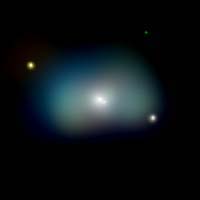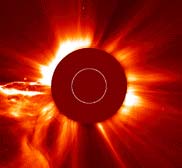This area deals with the fundamental laws and building blocks of nature and how they interact, the properties and the behavior of matter, and research into space and time and their structures.
innovations-report provides in-depth reports and articles on subjects such as astrophysics, laser technologies, nuclear, quantum, particle and solid-state physics, nanotechnologies, planetary research and findings (Mars, Venus) and developments related to the Hubble Telescope.

The European Investment Bank (EIB) is lending EUR 300 million to finance the final phase of construction of the Large Hadron Collider (LHC) at CERN, the European Organization for Nuclear Research. The loan will also help to finance the instrumentation to record and analyse the high-energy particle collisions at the LHC. A loan to enable construction of this major project was foreseen by CERN’s governing Council when it approved the LHC in 1996.
The EIB, the European Union’s long term

Ohio University astronomers have discovered the largest disk of hot, X-ray emitting gas ever observed in the universe: At 90,000 light years in diameter, it’s about 100,000 times the size of any comparable object. The disk, spinning through a distant galaxy, is more than just an interstellar oddity, the researchers say. The object could offer new information about the way certain galaxies form and evolve.
About 20 percent of all galaxies are elliptical, the largest of the three types of ga

Using a powerful new instrument at the South Pole, a team of cosmologists has produced the most detailed images of the early Universe ever recorded. The research team, which was funded by the National Science Foundation (NSF), has made public their measurements of subtle temperature differences in the Cosmic Microwave Background (CMB) radiation. The CMB is the remnant radiation that escaped from the rapidly cooling Universe about 400,000 years after the Big Bang. Images of the CMB provide researchers

VLT Images Progenitors of Today’s Large Galaxies [1]
An international team of astronomers [2] has made the deepest-evernear-infrared Ks-band image of the sky, using the ISAAC multi-modeinstrument on the 8.2-m VLT ANTU telescope.
For this, the VLT was pointed for more than 100 hours under optimalobserving conditions at the Hubble Deep Field South (HDF-S) andobtained images in three near-infrared filters. The resulting imagesreveal extremely distant galaxies, which appear at

Reconnection, the merging of magnetic field lines of opposite polarity near the surface of the sun, Earth and some black holes, is believed to be the root cause of many spectacular astronomical events such as solar flares and coronal mass ejections, but the reason for this is not well understood. Researchers at Los Alamos National Laboratory now have a new theory that may explain the instability and advance the understanding of these phenomena.
Theorists Giovanni Lapenta of Los Alamos Nati

Study of planetary disks around T Tauri stars
If David Weintraub and Jeff Bary are right, there may be a lot more planets circling stars like the Sun than current models of star and planet formation predict.
The associate professor of astronomy at Vanderbilt and his graduate student are taking a critical look at T Tauri stars. These are stellar adolescents, less than 10 million years old, which are destined to become stars similar to the Sun as they age.
Classical T Taur